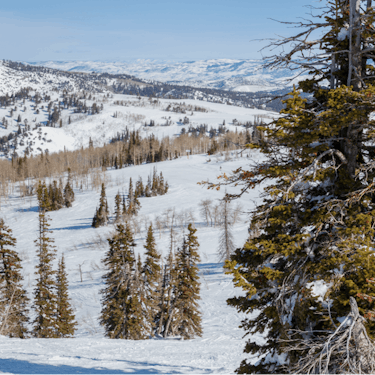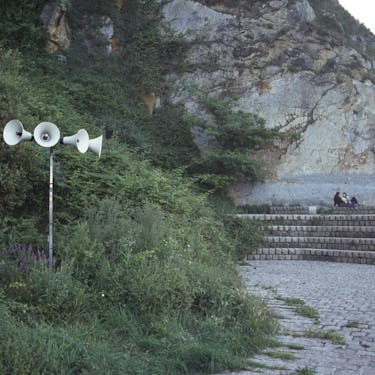Everyone has a distinct voice. Like a fingerprint, no two are alike. The human voice allows us to first identify loved ones, recognize emotions, to be heard, and to listen. Only humans learn vocal patterns and invent new ones by imitation. The ear and voice have a reciprocal relationship and complement each other: both are instruments activated by the movement of air, one percussive, the other reeded.

Susan Phillipsz

Susan Philipsz, We'll All Go Together, 2007. Installation view, Powder Mountain. Photo: Drew Rane.
The way we speak and sing leaves a strong impression on others. And one of the greatest gifts of empathy and compassion we can offer is often the silent presence of listening. Powder Mountain’s newest art installation by Scottish artist Susan Philipsz harnesses the resonance of the human voice and the emotional impact of introspective listening. Philipsz uses her voice and the sculptural elements of sound and song to create a sense of intimacy in public spaces. Her works are frequently songs sung in the first person, and Philipsz sings unaccompanied, her voice unaltered and unproduced, evoking the fragile intimacy of a lullaby. Her raw voice creates a singular, emotionally charged experience of the location, creating a feeling of a private moment in a public space. Philipsz has always loved to sing but cannot read music and lacks any formal training. The unstudied quality of her voice makes it easy to identify with, calling to mind the familiar feeling of singing to oneself in the shower or gently humming a baby to sleep. Punctuated by silence, which create moments of wonder and surprise, as well as allow for a deeper focus on the work itself, her works engage the full spectrum of the human’s voice’s unique blend of emotion, communication, and connection.

Susan Philipsz, The Lost Relfection, 2007. Installation view, Torminbrücke, Münster, Germany, 2007. Courtesy the artist; Isabella Bortolozzi Gallery, Berlin; and Tanya Bonakdar Gallery, New York / Los Angeles.
Originally trained as a sculptor, Philipsz uses sound to define and inhabit public or communal space. The sites where her works are encountered are varied and idiosyncratic: not only in museums or civic plazas and squares, but also inside a chimney breast in a former assisted-living home; under a bridge over a picturesque man-made lake; inside a supermarket, and now, in a forest glade off the Sunrise poma lift at Powder Mountain, framed by panoramic views of the Logan valley that stretch across state lines to Idaho and Wyoming.

Susan Philipsz, We'll All Go Together, 2007. Installation view, Powder Mountain. Photo: Drew Rane.
The sources of the songs in her work have a similarly wide range. She never writes her own songs, instead treating music as a found object to be re-interpreted and re-contextualized, borrowing from sources as varied as film soundtracks, pop music, and folk songs.

Susan Philipsz, Wild is the Wind, 2002. Installation view, Comb of the Winds, Donostia-San Sebastian as part of the exhibition Front Line Compilation. D.A.E. Donostia-San Sebastian (Spain), 2002. Photo by Eoghan McTigue. Courtesy the artist and Tanya Bonakdar Gallery, New York / Los Angeles.
In We’ll All Go Together, Philipsz sings the 18th Century American folk hymn “Am I Born to Die.” The song describes a state between life and death, contemplating the possibility of a life after death but not being sure. Susan has sung the song in a round with one voice following the other, which suggests a cycle of life, death and rebirth. Against the backdrop of Powder Mountain’s vast terrain and the seemingly endless peaks beyond, Philipsz’s installation becomes it’s own kind of hymn, arresting the listener who happens upon it and calling them into the trees, into the unknown, in a moment of reflection on one’s meaning and purpose.
And am I born to die?
To lay this body down?
And must my trembling spirit fly
Into a world unknown
Soon as from earth I go
What will become of me
Eternal happiness or woe
What shall my portion be
A land of deepest shade
Unpierced by human thought
The dreary regions of the dead
Where all things are forgot
And am I born to die?
To lay this body down?
And must my trembling spirit fly
Into a world unknown

Three early Methodist leaders, Charles Wesley, John Wesley, and Francis Asbury, portrayed in stained glass at the Memorial Chapel, Lake Junaluska, North Carolina.
About Susan Philipsz
Born in 1965 in Glasgow, Philipsz currently lives and works in Berlin. She received the Turner Prize in 2010 and was awarded an OBE in 2014 for services to British art.
Philipsz has presented solo exhibitions at Kunstmuseum Bonn (2021), Castello di Rivoli in Italy (2019), Tate Modern (2018) and Tate Britain (2015) in London, Bonniers Konsthall in Stockholm (2017), Kunsthaus Bregenz in Austria (2016), Hamburger Bahnhof in Berlin (2014), the Carnegie Museum of Art in Pittsburgh (2013), K21 Standehaus Kunstsammlung Nordrhein-Westfalen in Dusseldorf, Germany (2013), Museum of Contemporary Art in Chicago (2011), Aspen Art Museum in Colorado (2010-11), Wexner Center for the Arts at Ohio State in Columbus, OH (2009-10), Museum Ludwig in Cologne, Germany (2009), Institute of Contemporary Art in London (2008), among others. Installations by Philipsz were included in Skulptur Projekte Muenster in 2007, the 55th Carnegie International in 2008 and the National Gallery of Victoria Triennial in 2020.
Philipsz’s work can be found in the collections of the Baltimore Museum of Art, Beyeler Foundation in Basel, Hamburger Kunsthalle in Hamburg, Carnegie Museum of Art in Pittsburgh, Castello di Rivoli in Italy, Solomon R. Guggenheim Museum in New York, Hirshhorn Museum and Sculpture Garden in Washington, DC, Museo Nacional Centro de Arte Reina Sofia in Madrid, Museum of Contemporary Art, Chicago, Museum Ludwig, Cologne, Germany, SFMOMA in San Francisco, The Tate in London, the Walker Art Center in Minneapolis, and the Brooklyn Museum in New York.